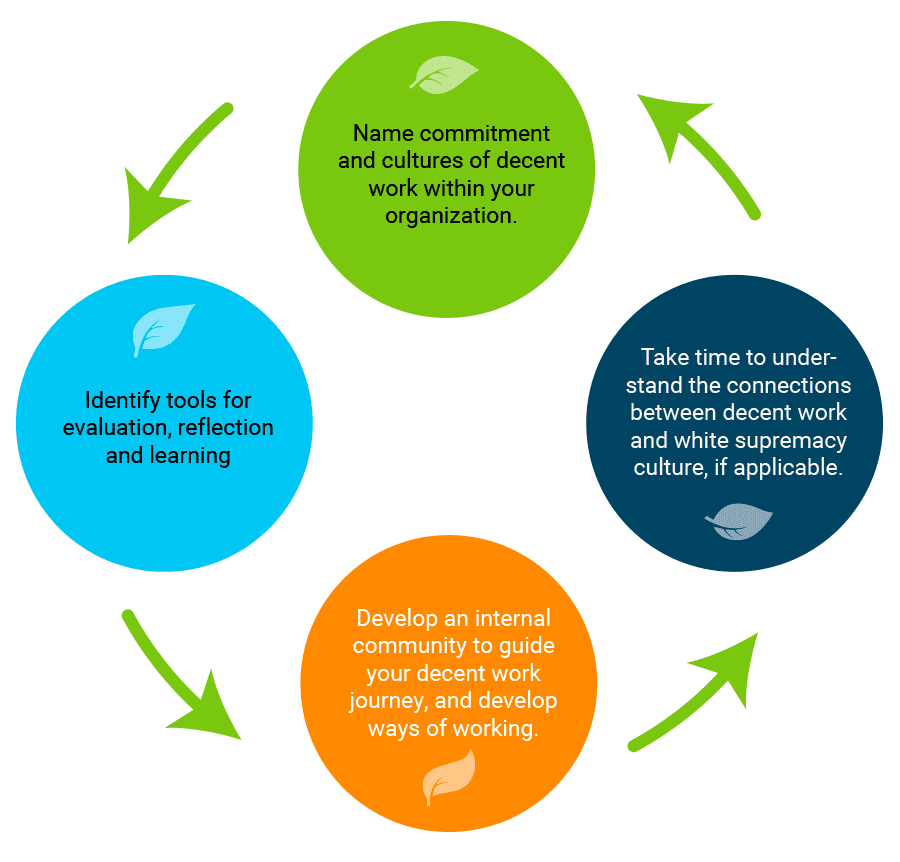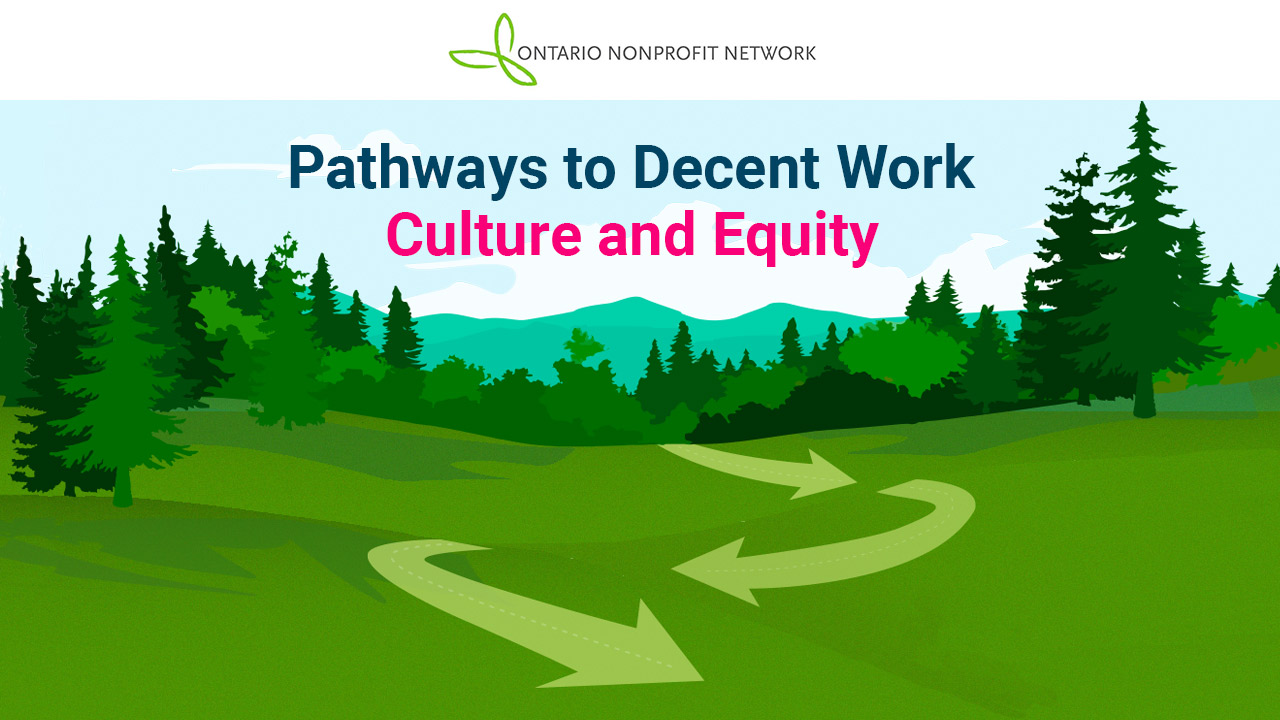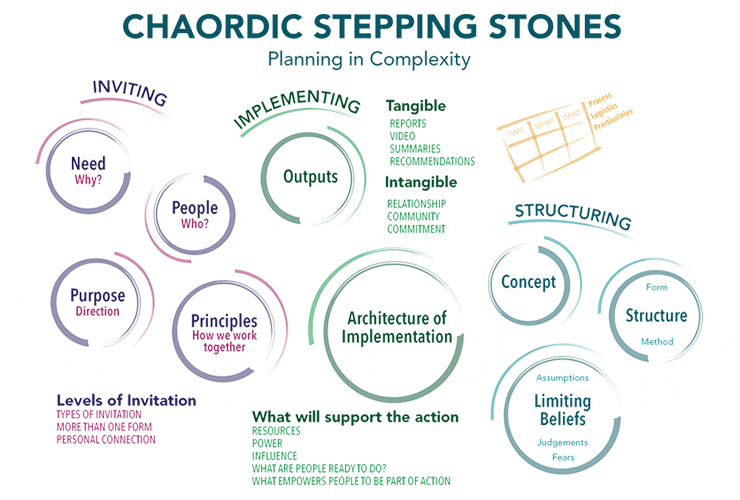Understanding decent work culture within your organization
Building Organizational Readiness
Identifying and naming culture is a critical practice in advancing decent work and equity within an organization. At this stage, we invite you to assess your context and landscape to understand how ready the organization is to take this leap.
- Build a team of people (can be 3-4) who can help anchor this work, and ensure that roles and responsibilities have been assigned, and followed through on. This team should reflect a mix of lived experiences, and institutional power across the organization. It is key that a member of senior leadership with the power to influence resources is part of this team. Important to remember that depending on roles within the organization, certain committee members may take on more work around implementation. Consider the emotional labour of equity deserving groups within your organization.
- Ensure there is an institutional commitment to advancing this work with clear goals, principles, practices, outcomes, assigned tasks, and a timeline. This commitment should be connected to organizational priorities and objectives. Recognize that priorities may change over time, though the institutional commitment should remain true and unwavering.
- Communicate the institutional commitment clearly and transparently to all members of the organization, and invite ongoing feedback.
- Implement clear, accessible, and accountable feedback loops that are assessed regularly.

For more information on organizational readiness assessment tools, check out this one by the Coalition of Communities of Color.


Developing community agreements can be a useful tool when bringing members within an organization together to assess equity, and decent working conditions.
Here are some helpful guidelines for developing community agreements:
1. Frame the conversation
Take time to define what a community agreement means.
Modify this definition if helpful:
“A consensus on what every person in our group needs from each other and commits to each other in order to feel safe, supported, open, productive and trusting… SO THAT we can serve our students (or clients) well, do our best work, and achieve our common vision.”
Delineate agreements from “rules” and “norms”. Agreements are an aspiration, or collective vision, for how we want to be in relationship with one another. They are explicitly developed and enforced by the group, not by an external authority, and as such must represent a consensus.
| Norms | Rules |
|---|---|
| Norms are the ways in which we behave and are currently in relationship to each other, whether consciously and explicitly or not. | Rules are mandated and enforced by an authority, and do not necessarily reflect the will or buy-in of the group. |
| Norms |
|---|
| Norms are the ways in which we behave and are currently in relationship to each other, whether consciously and explicitly or not. |
| Rules |
| Rules are mandated and enforced by an authority, and do not necessarily reflect the will or buy-in of the group. |
2. Explain that there are two types of community agreements
| Relational community agreements | Operational agreements |
|---|---|
| Relational community agreements are about how we want to be in relationship with each other (e.g. speak your truth using “I” statements; stay present; listen fully; seek out multiple perspectives). | Operational agreements identify procedures or structures we all agree to use (e.g. start & end on time; limit cell phone use; include process observations at each meeting; end with clear next steps). |
| Relational community agreements |
|---|
| Relational community agreements are about how we want to be in relationship with each other (e.g. speak your truth using “I” statements; stay present; listen fully; seek out multiple perspectives). |
| Operational agreements |
| Operational agreements identify procedures or structures we all agree to use (e.g. start & end on time; limit cell phone use; include process observations at each meeting; end with clear next steps). |
3. Explain “why” community agreements matter.
We can’t achieve our vision in a hostile, disrespectful, or undermining group culture.
“Some of the most critical conversations teams need to have are emotional, painful, and uncomfortable (e.g., equity issues, examining individual teacher practice), but we won’t engage or make ourselves vulnerable without emotional safety and trust.”
Source for quotes and content: Developing Community Agreements
“Culture is how our bodies retain and reenact history, through the foods we eat ( or refuse to eat) the stories we tell, the things that hold meaning for us; the images that move us, what we are and unable to sense or feel or process, the way we see the world and others aspects of life. Because culture lives in our bodies it usually trumps all things, cognitive— ideas, philosophies, convictions, principles and laws. Change culture and you change lives. You can also change the course of history.
Many well meaning social activists overlook this essential fact. They focus relentlessly on strategy, but strategy means nothing to our bodies and lizard brains. When strategy competes with culture , culture wins everytime. This is one of the reasons why the most brilliant anti-white supremacy strategies in the world have failed to dislodge white body supremacy from our culture.”
Quote source: Chapter 19 Creating Culture, My Grandmother’s Hands – Racialized Trauma and the Pathway to Mending Our Hearts and Bodies
Questions on organizational culture:
What are the written and unwritten rules within your organization? What are the norms, practices, ways of working that shape your organizational culture?
Who are the elders, community members, leaders that your organization seeks mentorship from?
How does your organization name practices around work culture? What are the codes of conduct that govern work culture (written and unwritten?)
How does white supremacy show up within your organizational culture? What are those behaviours?
| Reflection questions | |
|---|---|
| How does your organization define decent work? | |
| Do you have an organizational commitment to decent work that has been named explicitly? Where? | |
| How has the organizational commitment to decent work been shared/articulated with staff members? How often is it revisited? | |
| Is there a connection between reconciliation, equity and anti-racism within your decent work commitment?
Has the organization examined the consequences of not adopting decent work practices? |
|
| Assess – Where are the places that decent work implementation can go wrong? (i.e. the organization lacks capacity due to funding, staff turn over, etc) | |
| What are the actions that your organization can take to improve the existing culture? How are you setting goals toward decent work, what are the timelines, and delegation of tasks to people who should carry them out? | |
| What are the challenges to actioning the decent work charter? What are the barriers (e.g. funding) to enacting decent work principles outside of systemic factors? |
While culture change/shift may be difficult to measure, there are some tools that can help nonprofits think about where it has been, and where it would like to go. Evaluation, in particular, may be one way to capture the journey, celebrate successes, and pinpoint emerging needs. There is no singular way of engaging in evaluation when it comes to advancing decent work and equity. When working with nonprofits across Ontario, we found that challenges often showed up when trying to evaluate advancement of equity, with the biggest concern being rooted in not wanting to treat decent work, equity, and racial justice, including actions towards truth and reconciliation, as a check box. With that being said, evaluating the progression of decent work within an organization can take on various forms.
There is flexibility in evaluation and data collection tools that invite authenticity to the organization’s practices. In the decent work and data primer, we discuss key considerations when collecting data for the purposes of advancing decent work, recognizing that practices of data collection, and evaluation have been used in ways that have caused harm. We know that data or information is not neutral. Data collection efforts should be rooted in intersectional, anti-racist, and culturally relevant practices.
| Chaordic Stepping Stones | How the tool can be used |
|---|---|
|
“Working in the chaordic space” The term “chaordic” comes from combining the words chaos and order. It is a word coined by Dee Hock to identify organizations that intentionally blend characteristics of chaos and order. In this document, we use this term to indicate that we are working in a space of complexity, where there is much that is unpredictable, and unknown. Our job as people who are hosting strategic work in this space – whether it is a conversation, a meeting or a longer term strategic initiative – is to bring some form of order to the unpredictability, while letting the emergent properties of complex systems bring us new ideas, insight, and innovation. |
This tool can be used by core teams that come together around a strategic need, and purpose, to continually refine their design for their work. The tool is designed to be used collectively, and structured around a series of questions that can be answered by a group. Participatory processes require participatory leadership and these questions will help you guide your planning to get the most out of a group. The tool can be used sequentially to plan out a project, and it can be used as a reflective tool to review, and refine the work. |
| Chaordic Stepping Stones |
|---|
|
“Working in the chaordic space” The term “chaordic” comes from combining the words chaos and order. It is a word coined by Dee Hock to identify organizations that intentionally blend characteristics of chaos and order. In this document, we use this term to indicate that we are working in a space of complexity, where there is much that is unpredictable, and unknown. Our job as people who are hosting strategic work in this space – whether it is a conversation, a meeting or a longer term strategic initiative – is to bring some form of order to the unpredictability, while letting the emergent properties of complex systems bring us new ideas, insight, and innovation. |
| How the tool can be used |
|
This tool can be used by core teams that come together around a strategic need, and purpose, to continually refine their design for their work. The tool is designed to be used collectively, and structured around a series of questions that can be answered by a group. Participatory processes require participatory leadership and these questions will help you guide your planning to get the most out of a group. The tool can be used sequentially to plan out a project, and it can be used as a reflective tool to review, and refine the work. |

Resources
A non-exhaustive list of resources that seek to reduce harm when evaluating and collecting data:
Developmental Evaluation Primer
An Inclusive Gender Menu | YouthREX
tipsheet_how-can-we-use-evaluation-findings-to-reflect-on-and-adjust-our-work.pdf



